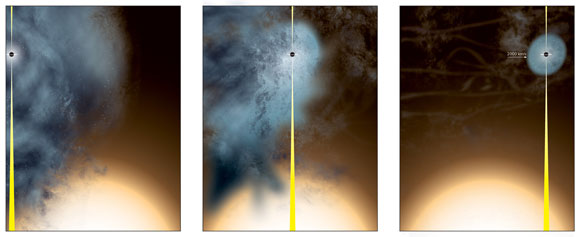Astronomers Discover a”Nearly Naked” Supermassive Black Hole
 Nov. 04: Using the Very Long Baseline Array a team of astronomers has discovered the shredded remains of a galaxy that passed through a larger galaxy, leaving only the smaller galaxy’s nearly-naked supermassive black hole to emerge and speed away at more than 2,000 miles per second.
Nov. 04: Using the Very Long Baseline Array a team of astronomers has discovered the shredded remains of a galaxy that passed through a larger galaxy, leaving only the smaller galaxy’s nearly-naked supermassive black hole to emerge and speed away at more than 2,000 miles per second.
The galaxies are part of a cluster of galaxies more than 2 billion light-years from Earth. The close encounter, millions of years ago, stripped the smaller galaxy of nearly all its stars and gas. What remains is its black hole and a small galactic remnant only about 3,000 light-years across. For comparison, our Milky Way Galaxy is approximately 100,000 light-years across.
The discovery was made as part of a program to detect supermassive black holes, millions or billions of times more massive than the Sun, that are not at the centers of galaxies. Supermassive black holes reside at the centers of most galaxies. Large galaxies are thought to grow by devouring smaller companions. In such cases, the black holes of both are expected to orbit each other, eventually merging.
“We were looking for orbiting pairs of supermassive black holes, with one offset from the center of a galaxy, as telltale evidence of a previous galaxy merger,” said James Condon, of the National Radio Astronomy Observatory. “Instead, we found this black hole fleeing from the larger galaxy and leaving a trail of debris behind it,” he added.
“We’ve not seen anything like this before,” Condon said.
The astronomers began their quest by using the VLBA to make very high resolution images of more than 1,200 galaxies, previously identified by large-scale sky surveys done with infrared and radio telescopes. Their VLBA observations showed that the supermassive black holes of nearly all these galaxies were at the centers of the galaxies.
However, one object, in a cluster of galaxies called ZwCl 8193, did not fit that pattern. Further studies showed that this object, called B3 1715+425, is a supermassive black hole surrounded by a galaxy much smaller and fainter than would be expected. In addition, this object is speeding away from the core of a much larger galaxy, leaving a wake of ionized gas behind it.
The scientists concluded that B3 1715+425 is what has remained of a galaxy that passed through the larger galaxy and had most of its stars and gas stripped away by the encounter — a “nearly naked” supermassive black hole.
The speeding remnant, the scientists said, probably will lose more mass and cease forming new stars.
“In a billion years or so, it probably will be invisible,” Condon said. That means, he pointed out, that there could be many more such objects left over from earlier galactic encounters that astronomers can’t detect.
The scientists will keep looking, however. They’re observing more objects, in a long-term project with the VLBA. Since their project is not time-critical, Condon explained, they use “filler time” when the telescope is not in use for other observations.
“The data we get from the VLBA is very high quality. We get the positions of the supermassive black holes to extremely good precision. Our limiting factor is the precision of the galaxy positions seen at other wavelengths that we use for comparison,” Condon said. With new optical telescopes that will come on line in future years, such as the Large Synoptic Survey Telescope (LSST), he said, they will then have improved images that can be compared with the VLBA images. They hope that this will allow them to discover more objects like B3 1714+425.
“And also maybe some of the binary supermassive black holes we originally sought,” he said.
Condon worked with Jeremy Darling of the University of Colorado, Yuri Kovalev of the Astro Space Center of the Lebedev Physical Institute in Moscow, and Leonid Petrov of the Astrogeo Center in Falls Church, Virginia. The scientists are reporting their findings in the Astrophysical Journal.
Source: National Radio Astronomy Observatory
